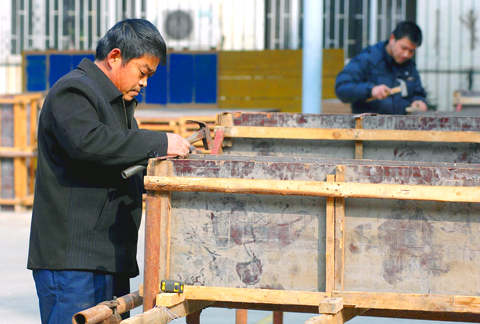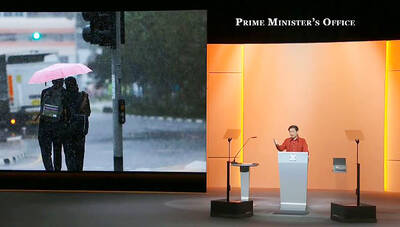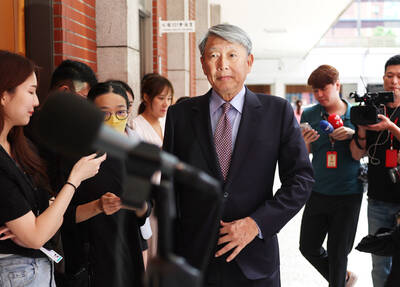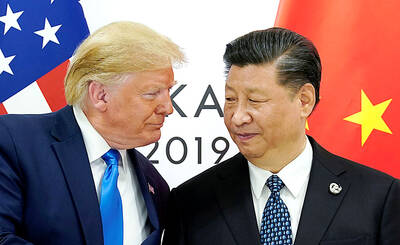It is China’s disconcerting secret: Its economic slump is much deeper than official data show.
The government says the economy grew by 6.8 percent in the final quarter of last year, but that is based on an outdated system that measures growth against the same period a year earlier.
Compared with the previous quarter, the method used by most major economies, growth was as low as 1 percent and possibly zero, economists say.

PHOTO: EPA
“We sharply decelerated in November and December,” Standard Chartered economist Stephen Green said. “There are no clear signals we have accelerated.”
If China’s economy is indeed barely growing, that would dash hopes China, the world’s third-largest economy, might drive the world out of recession. It also means communist leaders face a tougher challenge than outsiders might think as they scramble to stem a flood of job losses and ignite a recovery.
Other Asian economies such as Japan and South Korea are already contracting. Beijing says there are signs its 4 trillion yuan (US$586 billion) stimulus launched in November is taking effect. But its data might be giving companies and investors an overly positive picture of its current health.
Other countries such as the US and Japan report GDP growth by comparing each quarter with the previous quarter. That requires more number crunching to adjust for seasonal differences but quickly reveals changes in performance.
The gap is well-known to private sector economists, who try to estimate China’s quarter-on-quarter growth based on skimpy government data.
Fourth-quarter expansion from the previous three months was “close to zero,” said Ting Lu (陸挺), a Merrill Lynch economist.
Green said his early estimate showed it was “basically zero,” though he raised that to 1 percent after more calculation.
Still, he said, growth was unlikely to revive in the current quarter.
That would be more in line with indicators that show China’s exports and manufacturing shrinking and weakness in investment and consumer spending. The government says at least 20 million migrant workers have lost their jobs.
JP Morgan gave a more robust estimate of 1.5 percent quarter-on-quarter growth. But its figures also highlight a sharp decline: That rate is just one-tenth of the 15 percent quarter-on-quarter growth the bank says China achieved in early 2007.
Recent numbers suggest that China’s economy may be regaining some momentum. A key indicator of manufacturing improved last month, suggesting the slump may be bottoming out.
For decades Chinese economic data was thought to be heavily massaged.
Local leaders were accused of sending Beijing phony growth figures to make themselves look better. The government was accused of manipulating the final numbers to show it was achieving its goals.
Today, the Cabinet’s National Statistics Bureau is regarded as professional and honest but is struggling to keep up with China’s rapid economic evolution. Its small staff repeatedly revises past growth estimates as new data come in.
It was only in 2005 that booming service industries such as restaurants were counted in economic output. That forced the bureau to revise a decade’s worth of growth figures. But only annual numbers were revised, not those for each quarter, making it harder for analysts to make historical comparisons.
“China’s statistics system is really in a mess,” Lu said.
“It’s extremely difficult and close to impossible to calculate the quarter-on-quarter growth rate in China,” Lu said.
Ma Jiantang (馬建堂), commissioner of the statistics bureau, says the bureau wanted to create a reporting system like those of other countries.
“We are doing research right now on setting up this system,” Ma said last month, though he gave no timetable.
Last month, the bureau made the surprise announcement that it was raising 2007’s annual growth rate from an already stunning 11.9 percent. That meant China surpassed Germany that year to become the third-largest economy after the US and Japan — a milestone that went undetected at the time.
For this year, forecasts of full-year growth are as low as 5 percent — the best of any major country but China’s weakest in nearly two decades.

In his National Day Rally speech on Sunday, Singaporean Prime Minister Lawrence Wong (黃循財) quoted the Taiwanese song One Small Umbrella (一支小雨傘) to describe his nation’s situation. Wong’s use of such a song shows Singapore’s familiarity with Taiwan’s culture and is a perfect reflection of exchanges between the two nations, Representative to Singapore Tung Chen-yuan (童振源) said yesterday in a post on Facebook. Wong quoted the song, saying: “As the rain gets heavier, I will take care of you, and you,” in Mandarin, using it as a metaphor for Singaporeans coming together to face challenges. Other Singaporean politicians have also used Taiwanese songs

NORTHERN STRIKE: Taiwanese military personnel have been training ‘in strategic and tactical battle operations’ in Michigan, a former US diplomat said More than 500 Taiwanese troops participated in this year’s Northern Strike military exercise held at Lake Michigan by the US, a Pentagon-run news outlet reported yesterday. The Michigan National Guard-sponsored drill involved 7,500 military personnel from 36 nations and territories around the world, the Stars and Stripes said. This year’s edition of Northern Strike, which concluded on Sunday, simulated a war in the Indo-Pacific region in a departure from its traditional European focus, it said. The change indicated a greater shift in the US armed forces’ attention to a potential conflict in Asia, it added. Citing a briefing by a Michigan National Guard senior

CHIPMAKING INVESTMENT: J.W. Kuo told legislators that Department of Investment Review approval would be needed were Washington to seek a TSMC board seat Minister of Economic Affairs J.W. Kuo (郭智輝) yesterday said he received information about a possible US government investment in Taiwan Semiconductor Manufacturing Co (TSMC, 台積電) and an assessment of the possible effect on the firm requires further discussion. If the US were to invest in TSMC, the plan would need to be reviewed by the Department of Investment Review, Kuo told reporters ahead of a hearing of the legislature’s Economics Committee. Kuo’s remarks came after US Secretary of Commerce Howard Lutnick on Tuesday said that the US government is looking into the federal government taking equity stakes in computer chip manufacturers that

US President Donald Trump on Friday said that Chinese President Xi Jinping (習近平) told him China would not invade Taiwan while Trump is in office. Trump made the remarks in an interview with Fox News, ahead of talks with Russian President Vladimir Putin over Moscow’s invasion of Ukraine. “I will tell you, you know, you have a very similar thing with President Xi of China and Taiwan, but I don’t believe there’s any way it’s going to happen as long as I’m here. We’ll see,” Trump said during an interview on Fox News’ Special Report. “He told me: ‘I will never do